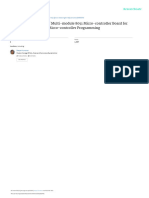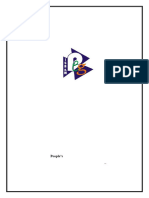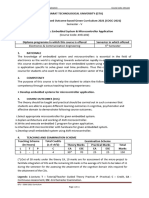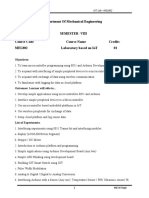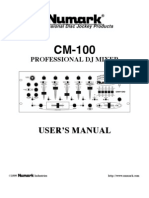Micro Controller
Micro Controller
Uploaded by
Yogesh MakwanaCopyright:
Available Formats
Micro Controller
Micro Controller
Uploaded by
Yogesh MakwanaOriginal Description:
Copyright
Available Formats
Share this document
Did you find this document useful?
Is this content inappropriate?
Copyright:
Available Formats
Micro Controller
Micro Controller
Uploaded by
Yogesh MakwanaCopyright:
Available Formats
Microcontroller
Course Code: 3351101
GUJARAT TECHNOLOGICAL UNIVERSITY, AHMEDABAD, GUJARAT
COURSE CURRICULUM
COURSE TITLE: MICROCONTROLLER
(COURSE CODE: 3351101)
Diploma Programme in which this course is offered
Semester in which offered
5th Semester
Electronics and Communication Engineering
1.
RATIONALE
Microcontroller is the sole of all embedded electronic equipments and is used in most of the
areas of electronics. They include product ranges from tiny consumer electronic products to
complex industrial process controllers. A diploma engineer needs to maintain such systems.
Programming practices will further help the students to develop indigenous microcontroller
based applications. Hence this course is designed to achieve the above.
2.
LIST OF COMPETENCY
The course content should be taught and implemented with the aim to develop different types
of skills so that students are able to acquire following competency:
Maintain microcontroller based equipments/system.
3.
COURSE OUTCOMES
The theory should be taught and practical should be carried out in such a manner that students
are able to acquire different learning outcomes in cognitive, psychomotor and affective
domain to demonstrate following course outcomes.
i. Identify features of various microcontroller
ii. Select appropriate microcontroller for different application
iii. Interface microcontroller with hardware for given application
iv. Write and execute assembly language programs(software) for given application
v. Develop small microcontroller based applications.
4.
TEACHING AND EXAMINATION SCHEME
Teaching Scheme
(In Hours)
Total
Credits
(L+T+P)
Examination Scheme
Theory Marks
Practical
Marks
ESE
PA
ESE
PA
70
30
20
30
Total
Marks
150
Legends: L-Lecture; T Tutorial/Teacher Guided Theory Practice; P - Practical; C Credit, ESE - End Semester Examination; PA Progressive Assessment
GTU/ NITTTR Bhopal/14-15
Gujarat State
Microcontroller
Course Code: 3351101
5.
COURSE DETAILS
Unit
Major Learning Outcomes
Topics and Sub-topics
( outcomes in Cognitive Domain)
Unit I.
Introduction
of
Microcontro
llers
1a.
Describe functions of each
block. diagram of generic digital
computer
1b.
Describe common features
of Microcontrollers
1c.
Differentiate between
microprocessor and microcontroller
1d.
Describe Evolution of
Microcontrollers
1e.
Explain various
architectures of microcontroller
1f.
Describe applications of
microcontrollers
Unit II
8051
Hardware
2a
Explain functions of each
block of 8051microcontroller
2b
Explain Pin Diagram of
8051
2c
Distinguish of clock, reset
and machine cycle of 8051with the
help of relevant waveform
2d Explain Memory organization
of 8051
1.1
Block diagram of
microcontroller : CPU, input device,
output device, memory and buses
1.2
common features of
Microcontrollers :
On-chip Oscillator, program and data
memory, I/O Ports, Watchdog- timer
reset, SFRs, Timers, Counters,
Interrupts, ADC, PWM
1.3
microprocessor and
microcontroller
1.4
Hierarchy of microcontrollers
1.5
architectures of
microcontroller
Harvard , Von Neumann
RISC and CISC
1.6
Applications: House hold ,
Communication, Office equipment
and industrial automation
2.1
Blocks of Microcontroller
8051:
ALU, PC, DPTR, PSW, Internal
RAM, Internal ROM, Latch, SFRs,
General purpose registers,
Timer/Counter, Interrupt, Ports
2.2
Functions of each pin of 8051
2.3
Clock circuit, reset Circuit ,
phase and state in machine cycle of
8051
2.4
Memory organization of
8051:
Program and Data memory Map,
External Memory Addressing and
Decoding Logic of 8051
2e
Differentiate Stack , Stack
2.5
Stack, Stack Pointer and
Pointer and stack operation
Stack operation
2f
Describe modes of operation 2.6
Timers/Counters logic
of Timers/Counters
diagram and its operation in various
modes
2g
Explain function and
2.7
I/O Ports structure: Port 0,
structure of I/O Ports
Port 1, Port2, Port 3.
2h
Describe Serial
2.8
Serial Communication in
communication
various modes
2i
Justify need of Interrupt
2.9
Interrupt structure, vector
Mechanism
address, priority and operation
GTU/ NITTTR Bhopal/14-15
Gujarat State
Microcontroller
Unit
Course Code: 3351101
Topics and Sub-topics
Major Learning Outcomes
( outcomes in Cognitive Domain)
Unit III
8051
Programmi
ng
2j
Differentiate various types
of Interrupts
2k
Explain various controlling
modes of 8051
3a
Classify addressing modes
of 8051 with example
3b
Sort the Instruction set of
8051as per functions performed by
them
3c
Explain following
Programming concept: Looping,
Counting and Indexing
3d
Develop simple programs to
perform the following operations:
Data manipulation, Masking, Stack
operation, Conditional execution
3e
Explain functions of Timer/
Counters and its application
3f
Describe modes of timers
3g
Explain the interrupt
mechanism with the help of suitable
example
3h
Explain I/O Port
Programming
GTU/ NITTTR Bhopal/14-15
2.10
Modes of operation: Power
down and idle mode
3.1
Addressing Modes :
Immediate, Register, Direct, Indirect,
Indexed, Relative and bit addressing
3.2
Instruction set :Data Transfer,
Arithmetic, Logical, Branching, and
Machine Control
3.3
Looping , Counting, sorting
and Indexing
3.4
Data manipulation, Masking ,
Stack operation, Conditional
programming
3.5
Configuration and
programming of Timer/Counter
using SFRs: TMOD, TCON, THx,
TLx.
3.6
Configuration and
programming of interrupts using
SFRs: IE,IP
3.7
Configuration and
programming of I/O Port :
P0,P1,P2,P3
Gujarat State
Microcontroller
Unit
Course Code: 3351101
Topics and Sub-topics
Major Learning Outcomes
( outcomes in Cognitive Domain)
UnitIV
8051
Interfacing
Unit-V
8051
Applications
4a
Interface Input Devices with
8051 microcontroller
4b
Interface Output devices
with 8051 microcontroller
4c
Interface ADC with 8051
microcontroller
4d
Interface Analog Input
devices with 8051 microcontroller
4e
Interface DAC with 8051
microcontroller
4f
Interface Analog Output
devices with 8051 microcontroller
4g
Interface actuator with 8051
microcontroller
4h
Interface PC with 8051
microcontroller
4i
Describe functions of
MAX232
4.1
4.2
4.3
Switch: Pushbutton, DIP,
Thumbwheel, Tilt
Relay,LED,7 segment
LED,LCD
ADC0804
4.4
Temperature sensor LM35
4.5
DAC0808, ADC0804,
4.6
Damper Control, Hoper
Control
DC Motor, Stepper motor
4.7
4.8
Serial communication using
MAX 232,Hyperterminal
5a List Various 8051 Applications 5.1 Application of microcontroller in
various field
5b Room Temperature Indicator
5.2 Using LM35, ADCC0804,
Microcontroller, 7 segment LED
5c Battery voltage logging system
5.3 Using Analog Multiplexer
4051,ADC0804,Microcontroller,
7 segment LED,MAX232
5d GSM based Security Application 5.4 Using GSM Modem,
Microcontroller, Relay, Switches
5e RPM Meter
5.5 Using Photo interrupter,
Microcontroller, 7 Segment LED
5.6 Using Pushbutton switches,
Microcontroller, Relay, NVRAM
5f Applications based on RTC
DS1307
6.
SUGGESTED SPECIFICATION TABLE WITH HOURS AND MARKS (THEORY)
Unit
No.
I
II
III
IV
V
Unit Title
Teaching
Hours
Introduction of Microcontrollers
8051 Hardware
8051 Programming
8051 Interfacing
8051 Applications
10
16
12
10
8
56
Total
Distribution of Theory Marks
R
U
A
Total
Level
Level
Level
Marks
04
04
04
12
08
06
04
18
06
05
05
16
04
06
04
14
02
02
06
10
24
23
23
70
Legends: R = Remember U = Understand; A = Apply and above levels (Blooms revised taxonomy)
Note: This specification table shall be treated as a general guideline for students and teachers. The actual
distribution of marks in the question paper may vary slightly from above table.
GTU/ NITTTR Bhopal/14-15
Gujarat State
Microcontroller
Course Code: 3351101
7.
SUGGESTED LIST OF EXERCISES/PRACTICALS
The practical/exercises should be properly designed and implemented with an attempt to
develop different types of skills (outcomes in psychomotor and affective domain) so that
students are able to acquire the competencies/programme outcomes. Following is the list of
practical exercises for guidance.
Note: Here only outcomes in psychomotor domain are listed as practical/exercises. However,
if these practical/exercises are completed appropriately, they would also lead to development
of certain outcomes in affective domain which would in turn lead to development of Course
Outcomes related to affective domain. Thus over all development of Programme Outcomes
(as given in a common list at the beginning of curriculum document for this programme)
would be assured.
Faculty should refer to that common list and should ensure that students also acquire
outcomes in affective domain which are required for overall achievement of Programme
Outcomes/Course Outcomes.
Note: It is preferable to use 8051 Trainer kits rather than Simulation tools for better hands
on practice.
S. No.
1
2
3
Unit
No.
I
I
II
II
4
5
6
7
8
9
10
11
12
13
14
15
16
17
18
II
II
II
III
III
III
IV
IV
IV
IV
V
V
V
V
Practical Exercises
(outcomes in Psychomotor Domain)
Use 8051 Simulation tool
Test and verify the features of 8051 Trainer Kit
Write and execute assembly language programs based on Data
transfer Instructions
Develop assembly language programs based on Arithmetic
Instructions (e.g. 8 bit Addition , Subtraction, Multiplication,
Division)
Develop Assembly Language Programs based on Logical
Instructions (And, Or etc.)
Develop Assembly Language Programs based on Branch
Instructions
Develop Assembly Language Programs based on Looping
,Counting and Indexing concept
Develop Assembly Language Programs to introduce delay
(e.g.1ms Delay) using Timer/Counter
Develop Assembly Language Programs for Interrupts
Develop Programs for serial communication
Develop a program to interface LED with 8051
Develop a program to interface 7 segment Display with 8051
Develop a program to Interface 8 bit DAC with 8051
Develop a program to interface a DC Motor with 8051
Develop a program to interface LCD Module with 8051
Develop a 4 bit binary counter with 8051 and display out put on
LCD
Develop a program to interface a Stepper Motor with 8051
Develop a data acquisition system using ADC0804 and
Microcontroller
Total Hours (perform practical form every unit so that 28 hours are utilized)
GTU/ NITTTR Bhopal/14-15
Approx
Hours.
2
2
2
2
2
2
2
2
2
2
2
2
2
2
2
2
2
2
36
Gujarat State
Microcontroller
8.
i.
ii.
iii.
iv.
v.
9.
Course Code: 3351101
SUGGESTED LIST OF STUDENT ACTIVITIES
Following is the list of proposed student activities:
Prepare journals based on practical performed in laboratory.
Prepare chart to represent the block diagram of different interfacing chips.
Develop a practical application using 8051 Microcontroller
Prepare ISP board of 89V51RD2Hxx with all ports available as connector
Prepare/Download a dynamic animation to illustrate the following
Data transfer operation
Keypad Interfacing
LCD Interfacing
DC Motor Interfacing
SPECIAL INSTRUCTIONAL STRATEGIES (if any)
i. Arrange visit to relevant industry.
ii. Show video lectures on Microcontroller Applications with help of internet.
iii. Assemble level programming practices on simulators (free downloadable).
10.
A)
SUGGESTED LEARNING RESOURCES
List of Books
S.
No.
1.
2.
3.
4.
5.
6.
Title of Book
Microcontrollers : Principles
And Applications
The 8051 Microcontrollers:
Architecture, Programming
and Applications
The 8051 microcontroller and
embedded systems
The 8051 Microcontroller:
Architecture, Programming,
and Applications
The 8051 Microcontroller,
Programming and
customizing the 8051
microcontroller
Author
Pal Ajit
Rao Dr. K Uma
Publication
EEE, PHI ,New
Delhi,(Latest edition)
Pearson Education India,
New Delhi,(Latest edition)
Mazidi Ali,
Muhammad Mazidi
Gillispie Janice
Kenneth Ayala J.
PHI, New Delhi,(Latest
edition)
Mackenzie
Pearson Education India,
New Delhi,(Latest edition)
McGraw-Hill,
International edition
Predko Michael
Thomson Delmar
learning,(latest Edition)
B) List of Major Equipment/ Instrument with Broad Specifications
i. Microcontroller 8051 trainer Kit
ii. 8051 Simulator software (Free downloadable )
iii. Computer System(p-IV and latest version)
iv. Peripheral Interfacing Trainer kits
C) List of Software/Learning Websites
i. www.academia.edu
ii. www.learners TV.com
iii. www.nptel.iitm.ac.in
iv. www.8052.com
GTU/ NITTTR Bhopal/14-15
Gujarat State
Microcontroller
v.
vi.
vii.
viii.
ix.
x.
xi.
xii.
11.
Course Code: 3351101
http://www.slideshare.net/aismahesh/memory-8051
http://www.intorobotics.com/8051-microcontroller-programming-tutorialssimulators-compilers-and-programmers/
http://electrofriends.com/articles/electronics/microcontroller-electronicsarticles/8051-8951/80518951-microcontroller-instruction-set/
http://www.ikalogic.com/part-1-introduction-to-8051-microcontrollers
http://www.edsim51.com
http://www.mikroe.com/chapters/view/64/chapter-1-introduction-tomicrocontrollers/
http://www.8051projects.net/download-c4-8051-projects.html
http://cse.iitkgp.ac.in/~soumya/embcs/the-8051-microcontroller-0314772782.pdf
COURSE CURRICULUM DEVELOPMENT COMMITTEE
Faculty Members from Polytechnics
Prof. T P Chanpura, Sr. Lecturer (EC) ,Government Polytechnic
Ahmedabad
Prof. D H Ahir,
Sr.Lecturer (EC),Government Polytechnic Rajkot
Prof. N M Rindani, Sr.Lecturer (EC) ,AVPTI Rajkot
Prof. N B Shah,
Sr.Lecturer (EC),Government Polytechnic Vadnagar
Prof. Krunal Pithadia, Lecturer (EC),B & B Polytechnic Vallabh Vidhyanagar
Coordinator and Faculty Members from NITTTR Bhopal
Prof. (Mrs.) Anjali Potnis, Department of Electrical and Electronics Engineering.
GTU/ NITTTR Bhopal/14-15
Gujarat State
You might also like
- Axp322 Mode S Remote Transponder Installation ManualDocument36 pagesAxp322 Mode S Remote Transponder Installation Manualzach100% (7)
- PLC Programming from Novice to Professional: Learn PLC Programming with Training VideosFrom EverandPLC Programming from Novice to Professional: Learn PLC Programming with Training VideosRating: 5 out of 5 stars5/5 (1)
- Microprocessor PDFDocument3 pagesMicroprocessor PDFmkrajasekarNo ratings yet
- H Pss TechnicalDocument16 pagesH Pss TechnicalDawit Getachew Melssel100% (1)
- Government Polytechnic, Nagpur. Course Curriculum: Teaching SchemeDocument41 pagesGovernment Polytechnic, Nagpur. Course Curriculum: Teaching SchemeAkhilesh PandeNo ratings yet
- Programmable Logic Controllers (PLC) EEE220 PDFDocument7 pagesProgrammable Logic Controllers (PLC) EEE220 PDFTanaka dzapasi100% (1)
- Syllabus 5th Semester EE 24112022 RemovedDocument19 pagesSyllabus 5th Semester EE 24112022 Removedpuchughosh972No ratings yet
- 8051 MicrocontrollerDocument10 pages8051 Microcontrollerfirodiya121No ratings yet
- Development and Use of Multi-Module 8051Document6 pagesDevelopment and Use of Multi-Module 8051GameboySmitNo ratings yet
- Labsheet Ece521 Intel8051 Sept2013 PDFDocument11 pagesLabsheet Ece521 Intel8051 Sept2013 PDFWan Muhammad ZafriNo ratings yet
- Microcontroller Lab ManualDocument63 pagesMicrocontroller Lab Manualrobinmyow211No ratings yet
- ET3491 Final - Merged Full ManualDocument53 pagesET3491 Final - Merged Full Manualmanoj yohan100% (2)
- The Open University of Sri LankaDocument10 pagesThe Open University of Sri LankaNuwan SameeraNo ratings yet
- MC & ESY NotesDocument144 pagesMC & ESY NotesgodaserbNo ratings yet
- Embedded Manual PDFDocument56 pagesEmbedded Manual PDFAjay SuryaNo ratings yet
- Embedded System & Microcontroller Application Course Code: 4351102Document8 pagesEmbedded System & Microcontroller Application Course Code: 4351102Raggy TannaNo ratings yet
- Seminar Report On 8051 MicrocontrollerDocument21 pagesSeminar Report On 8051 MicrocontrollerChiyan RanjithNo ratings yet
- FlowchartDocument224 pagesFlowchartmubin.pathan765No ratings yet
- 21RA43 MicrocontrollerDocument4 pages21RA43 MicrocontrollerSamvrudh NagarajNo ratings yet
- LAB Manual Updated 2018Document127 pagesLAB Manual Updated 2018usmanzahidNo ratings yet
- Syllabus MicrocontrollerDocument3 pagesSyllabus MicrocontrollerharshithaNo ratings yet
- PLC Technician II ProgramDocument12 pagesPLC Technician II ProgramAnonymous 144EsBNo ratings yet
- 2152006Document3 pages2152006Mohamed Ismail FiazNo ratings yet
- Summer Internship Program 2012: Course ContentDocument3 pagesSummer Internship Program 2012: Course ContentjungyawarNo ratings yet
- Be Mech Iot-1Document42 pagesBe Mech Iot-1znbsshsh anhaNo ratings yet
- 08.607 Microcontroller Lab ManualDocument115 pages08.607 Microcontroller Lab ManualAssini Hussain100% (12)
- 8051 Microcontroller TrainingDocument7 pages8051 Microcontroller TrainingSarthak SisgainNo ratings yet
- 8051 Micro Controller Project ReportDocument42 pages8051 Micro Controller Project ReportRoshan Anand57% (7)
- Project FileDocument6 pagesProject Filefirodiya121No ratings yet
- 8051 Microcontroller Training ProgramDocument2 pages8051 Microcontroller Training ProgramSumit ChakravartyNo ratings yet
- R18 B.Tech Eie Iii YearDocument37 pagesR18 B.Tech Eie Iii YearkailashjkNo ratings yet
- Microcontroller Ab Manual NewDocument57 pagesMicrocontroller Ab Manual NewshilpaNo ratings yet
- Thesis On 8051 MicrocontrollerDocument8 pagesThesis On 8051 Microcontrollerdwt65fcw100% (2)
- PIC18 Study Guide CIEDocument110 pagesPIC18 Study Guide CIESushil Sirsat SVNITNo ratings yet
- Minor Project: DTMF Controlled Robot "Mobot"Document65 pagesMinor Project: DTMF Controlled Robot "Mobot"Shyami GovindNo ratings yet
- Hardware Training Report NEWDocument45 pagesHardware Training Report NEWhr. infotechnogenplNo ratings yet
- EE P62 Microprocessor & Microcontrollers LabDocument2 pagesEE P62 Microprocessor & Microcontrollers Labr gouthamNo ratings yet
- micro report (1)(4)Document12 pagesmicro report (1)(4)mardedevashish05No ratings yet
- 15ec563 - 8051 Microcontroller - Syllabus PDFDocument2 pages15ec563 - 8051 Microcontroller - Syllabus PDFNagesh100% (1)
- Lecture Notes of Microprocessor and Microcontroller-Converted-1 1650355636Document126 pagesLecture Notes of Microprocessor and Microcontroller-Converted-1 1650355636Deba Comedy ClubNo ratings yet
- CAO Lab ManualDocument59 pagesCAO Lab ManualDivyansh GuptaNo ratings yet
- Microcontroller Lab Manual - 2013-14Document42 pagesMicrocontroller Lab Manual - 2013-14Shalin Doshi100% (2)
- 6 1Document19 pages6 1Zubair AhmedNo ratings yet
- New Microprocessor Theory Course OutlineDocument6 pagesNew Microprocessor Theory Course OutlineusmanzahidNo ratings yet
- Square and Find 2's Complement of A NumberDocument1 pageSquare and Find 2's Complement of A NumberDev RajNo ratings yet
- Lab Initialization, GPIO, Basic SchedulingDocument6 pagesLab Initialization, GPIO, Basic Schedulingmasood ahmadNo ratings yet
- PLC Solution BookDocument49 pagesPLC Solution BookJagadeesh Rajamanickam71% (14)
- CP MPMC Ay22-23Document12 pagesCP MPMC Ay22-23Vedashree ShetyeNo ratings yet
- 17EC3652 Lab ManualDocument50 pages17EC3652 Lab ManualMmk ReddyNo ratings yet
- Microprocessor and Controller Applications Course Code: 4360902Document12 pagesMicroprocessor and Controller Applications Course Code: 4360902RajeshKoriya0% (1)
- Application Note: Ladder Logic/ Flowchart Programming Differences and ExamplesDocument10 pagesApplication Note: Ladder Logic/ Flowchart Programming Differences and ExamplesTony AndersonNo ratings yet
- 8051 MC 2010Document7 pages8051 MC 2010Vikram RaoNo ratings yet
- 8051tk2000.pub - BiPOM ElectronicsDocument22 pages8051tk2000.pub - BiPOM Electronicssivar22No ratings yet
- Training Report of Industrial Interaction in Cetpa Infotech PDFDocument40 pagesTraining Report of Industrial Interaction in Cetpa Infotech PDFmjdj1230% (1)
- Iare Mtech Eslab ManualDocument72 pagesIare Mtech Eslab ManualAdarsh Rai NMAMIT - MechNo ratings yet
- Programing & Interfacing 8051Document6 pagesPrograming & Interfacing 8051SAKETSHOURAVNo ratings yet
- PLC Programming & Implementation: An Introduction to PLC Programming Methods and ApplicationsFrom EverandPLC Programming & Implementation: An Introduction to PLC Programming Methods and ApplicationsNo ratings yet
- C Programming for the PIC Microcontroller: Demystify Coding with Embedded ProgrammingFrom EverandC Programming for the PIC Microcontroller: Demystify Coding with Embedded ProgrammingNo ratings yet
- Mamba 2Document2 pagesMamba 2alinupNo ratings yet
- Multi V IV Indoor PDFDocument526 pagesMulti V IV Indoor PDFDavid AlbortNo ratings yet
- Benchmark Games Ticket Station ManualDocument30 pagesBenchmark Games Ticket Station ManualkiranNo ratings yet
- DC Motor SpecsDocument1 pageDC Motor SpecsElbenNo ratings yet
- Medium Voltage Cables PDFDocument8 pagesMedium Voltage Cables PDFAnielaNo ratings yet
- Tta Elearning Courses RF and Microwave EngineeringDocument43 pagesTta Elearning Courses RF and Microwave EngineeringRakshithNo ratings yet
- ahmed samir .. كهرومغناطيسيةDocument13 pagesahmed samir .. كهرومغناطيسيةEldsoky DabaNo ratings yet
- ILED Aquarius Perimeter Light Specification Sheet 1Document4 pagesILED Aquarius Perimeter Light Specification Sheet 1bakien-canNo ratings yet
- Chương 2 Đặc trưng cảm biếnDocument23 pagesChương 2 Đặc trưng cảm biếnHuy NguyễnNo ratings yet
- User'S Manual: Professional DJ MixerDocument12 pagesUser'S Manual: Professional DJ MixerdionysiaNo ratings yet
- GE Fanuc Automation: Series 0i-Model B Series 0i-Mate Model BDocument712 pagesGE Fanuc Automation: Series 0i-Model B Series 0i-Mate Model BАнѓелковска МаријаNo ratings yet
- Technical Specification VCB PanelDocument14 pagesTechnical Specification VCB PanelDarshit VyasNo ratings yet
- Installing and Setting The Video RecorderDocument4 pagesInstalling and Setting The Video RecorderVlady Lopez CastroNo ratings yet
- tw250 1Document50 pagestw250 1pribadi socojatiNo ratings yet
- Superconductors and SupercapacitorsDocument12 pagesSuperconductors and SupercapacitorsjameshrclassesNo ratings yet
- DEVELOPMENT OF CONGESTION LEVEL BASED DYNAMIC TRAFFIC MANAGEMENT SYSTEM Major ReportDocument64 pagesDEVELOPMENT OF CONGESTION LEVEL BASED DYNAMIC TRAFFIC MANAGEMENT SYSTEM Major ReportBHARATHI GNo ratings yet
- Guía de FusiblesDocument11 pagesGuía de FusiblesbtoroNo ratings yet
- Wireless Charging of Mobile Phone Using Microwaves!Document5 pagesWireless Charging of Mobile Phone Using Microwaves!Hamza HebNo ratings yet
- Module 2: Instrument Types: Edb3013 Instrumentation & MeasurementDocument45 pagesModule 2: Instrument Types: Edb3013 Instrumentation & MeasurementM Rubin TasnimNo ratings yet
- PL15 OPEN TYPE Perkins Engine 403D-15GDocument6 pagesPL15 OPEN TYPE Perkins Engine 403D-15Gmyat thu htunNo ratings yet
- Self Switching Power SupplyDocument20 pagesSelf Switching Power SupplyPutra Purechk TokyoNo ratings yet
- Causes of Call Setup FailureDocument2 pagesCauses of Call Setup Failurediporufai100% (2)
- Speakers To Hang On For LifeDocument18 pagesSpeakers To Hang On For LifeenergiculNo ratings yet
- Preface: FR100L&FR200L For Wire Drawing MachineDocument28 pagesPreface: FR100L&FR200L For Wire Drawing MachineAch SyarifNo ratings yet
- Ak731 606 00 0 2PLC1Document138 pagesAk731 606 00 0 2PLC1Francisco MunguíaNo ratings yet
- Chapter 4: System Architecture: ADC Dma PicsDocument11 pagesChapter 4: System Architecture: ADC Dma Picscarlosmg4No ratings yet
- Catalogo Leeson Electric Co PDFDocument534 pagesCatalogo Leeson Electric Co PDFmtbecerrapNo ratings yet
- Dfa Saft Prospekt EnglischDocument42 pagesDfa Saft Prospekt Englischsalvador2me100% (2)








